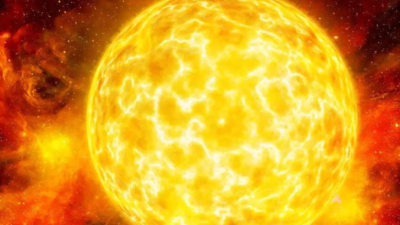- News
- Science News
- Nasa's Hi-C rocket experiment captures unprecedented view of solar flares
Nasa's Hi-C rocket experiment captures unprecedented view of solar flares
Nasa's Hi-C Flare mission, with advanced instruments from Marshall Space Flight Center, captures solar flares. The mission, led by Sabrina Savage, successfully launches sounding rockets to observe and analyze M-class flares, utilizing innovative solar flare prediction algorithms and COOL-AID data analysis by Amy Winebarger."}

Photo/Agencies
NEW DELHI: In an impressive display of scientific advancement and precise timing, Nasa's upgraded High Resolution Coronal Imager Flare mission, known as Hi-C Flare, has successfully captured never-before-seen views of solar flares. Launched from Poker Flat Research Range in Alaska, the mission utilizes a suite of cutting-edge instruments built at Nasa’s Marshall Space Flight Center in Huntsville, Alabama.
"This is a pioneering campaign," said Sabrina Savage, the principal investigator at Marshall for Hi-C Flare."Launching sounding rockets to observe the Sun to test new technologies optimized for flare observations has not even been an option until now." The mission marked the third flight for the Hi-C instrument but was the first to include ride-along instruments such as COOL-AID, CAPRI-SUN, and SSAXI, enhancing its observational capabilities.
The launch, executed towards the end of a two-week campaign window, was a result of meticulous planning and a bit of good fortune. "The Sun was unusually quiet throughout the campaign despite numerous active regions," Savage noted. "Both teams were getting nervous that we would not launch, but we finally got a nice long-duration M-class flare right before the window closed."
Once launched, the Hi-C Flare rocket directed its cameras towards the Sun, stabilizing its instrumentation to capture about five minutes of crucial data. After its brief mission, the rocket landed in the Alaskan tundra, where it remained until safe retrieval conditions allowed for data analysis. "It was an anxious few days, but the data are beautiful and were worth the wait," Savage expressed, underscoring the success of the mission.
The data retrieved from the Hi-C 3 and COOL-AID instruments have been particularly promising. "The COOL-AID data is the first spectrally pure image in a hot spectral line that we know of," said Amy Winebarger, project scientist at Marshall for Hi-C Flare.
The Hi-C experiment continues under the leadership of Marshall Space Flight Center, in collaboration with the Smithsonian Astrophysical Observatory and Montana State University, with support from Nasa's Sounding Rocket Program managed at Wallops Flight Facility by Nasa’s Goddard Space Flight Center.
"This is a pioneering campaign," said Sabrina Savage, the principal investigator at Marshall for Hi-C Flare."Launching sounding rockets to observe the Sun to test new technologies optimized for flare observations has not even been an option until now." The mission marked the third flight for the Hi-C instrument but was the first to include ride-along instruments such as COOL-AID, CAPRI-SUN, and SSAXI, enhancing its observational capabilities.
The launch, executed towards the end of a two-week campaign window, was a result of meticulous planning and a bit of good fortune. "The Sun was unusually quiet throughout the campaign despite numerous active regions," Savage noted. "Both teams were getting nervous that we would not launch, but we finally got a nice long-duration M-class flare right before the window closed."
Once launched, the Hi-C Flare rocket directed its cameras towards the Sun, stabilizing its instrumentation to capture about five minutes of crucial data. After its brief mission, the rocket landed in the Alaskan tundra, where it remained until safe retrieval conditions allowed for data analysis. "It was an anxious few days, but the data are beautiful and were worth the wait," Savage expressed, underscoring the success of the mission.
The Hi-C Flare mission not only tested new observational technologies but also utilized a novel algorithm designed to predict the behavior of solar flares, optimizing the timing of the launch. Genevieve Vigil, technical and camera lead for Hi-C 3 and COOL-AID at Marshall, highlighted the challenges: "To catch a flare in action is really hard, because you can’t predict them. We had to wait around for a solar flare to start going, then launch as it’s happening. No one has tried to do that before."
The data retrieved from the Hi-C 3 and COOL-AID instruments have been particularly promising. "The COOL-AID data is the first spectrally pure image in a hot spectral line that we know of," said Amy Winebarger, project scientist at Marshall for Hi-C Flare.
The Hi-C experiment continues under the leadership of Marshall Space Flight Center, in collaboration with the Smithsonian Astrophysical Observatory and Montana State University, with support from Nasa's Sounding Rocket Program managed at Wallops Flight Facility by Nasa’s Goddard Space Flight Center.
End of Article
FOLLOW US ON SOCIAL MEDIA

